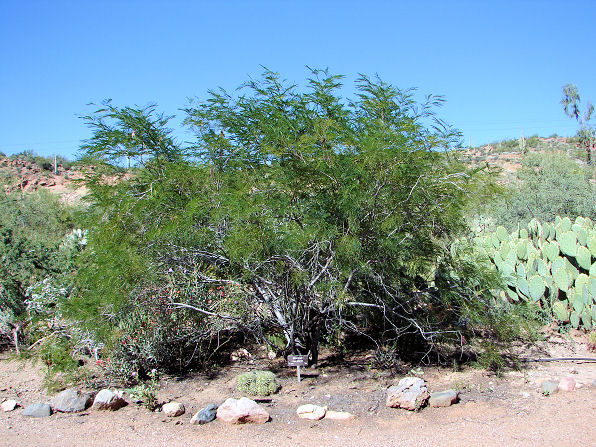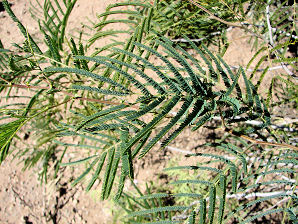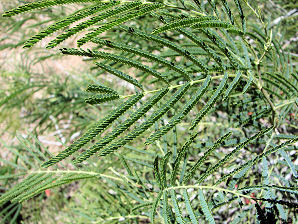Xeriscape Landscaping Plants For The Arizona Desert Environment.
Pictures, Photos, Information, Descriptions,
Images, & Reviews.
Trees.
Guajillo Acacia Trees, Acacia berlandieri.
We Are Proud Of Our SafeSurf Rating!
Click On Any Of The Following Links By Amazon.Com
For Books, & Videos About Wildflowers Of Arizona & The Southwest USA. No Obligation!
 |
| Guajillo Acacia, Acacia berlandieri, October 11, 2006. Boyce Thompson Arboretum, Near Superior, Arizona. |
|---|
 |  |
| Guajillo Acacia Leaves. Acacia berlandieri. | Guajillo Acacia Leaf. Acacia berlandieri. |
|---|---|
 | |
| Guajillo Acacia Flower. Acacia berlandieri. Courtesy Of Wikipedia. | Guajillo Acacia Seed. Acacia berlandieri. Courtesy Of Wikipedia. |
Guajillo Acacia Trees.
We wish to thank Wikipedia, the free encyclopedia for some of the information on this page. We share images and information with Wikipedia. Acacia berlandieri is a shrub native to the Southwestern United States and northeast Mexico that belongs to the subfamily Mimosoideae (wattles) of Fabaceae (legumes). Guajillo is a deciduous, to semi - evergreen, multi-trunked large shrub up to 9 to 15 feet tall and wide, that can be pruned to a small specimen tree. It has fern-like, lacy foliage, with an open, airy, rounded form and 1/2 inch creamy white spring flowers. Guajillo flower nectar is relished by honeybees and in Texas there are enough Guajillo plants, that the bees make a delicious sweet honey from Guajillo's fragrant flowers. Guajillo is useful as a hedge or fragrant speciman plant around pools or patios. It is native to dry limestone hillsides in South Central and West Texas. Guajillo is cold hardy to about 10 degrees F. In Phoenix winters it usually retains most of its leaves. It prefers full sun, is drought tolerant once established. Guajillo does have thorns, but they are small and not rigid and do not create a problem.
Quick Notes:
Height: Up To 9 - 15 feet tall and 9 - 15 feet wide.
Trunk: 3 to 8 inches in diameter.
Bark: Gray brown bark with a few small prickles.
Flowers: Creamy white, 1/2 inch diameter balls including many tiny stamens; very fragrant.
Blooming Time: Early February - March.
Seed Pod: 4 to 5 inch long hard, flat, velvety, brown seedpods.
Leaves: Grayish green, fern-like, bipinnately compound leaves, 4 to 6 inches long, with 6 to 10 pairs of pinnae, 30 to 40 very small leaflets.
Found: In the Chihuahuan desert. The USDA claims it is native to the USA (TX). In Texas it is mainly on the Edwards Plateau and the South Texas Plains. We have found that it is also native to southeastern New Mexico. Also native to Chihuahua, & Coahuila in Mexico; extending furthers southward into Hidalgo, Quer�taro, San Luis Potos�, Veracruz, & as far as into the central Mexico state of Oaxaca.
Elevation: Native at 1,000 to 3,000 feet.
Hardiness:
Soil pH requirements:
Sun Exposure:
Habitat: Rocky hillsides, alluvial plains, canyon slopes, and hillsides. Xeriscape ornamental in lower elevations in the Phoenix and Tucson areas of Arizona.
Miscellaneous: Photos Taken At October 11, 2006. Boyce Thompson Arboretum, near Superior, Arizona. A low water use landscaping plant in the Phoenix and Tucson areas.
|
We Are Proud Of Our SafeSurf Rating!
Click On Any Of The Following Links By Amazon.Com
For Books, & Videos About Wildflowers Of Arizona & The Southwest USA. No Obligation!
| © 1966 - Present, Audrey, Eve, & George DeLange |